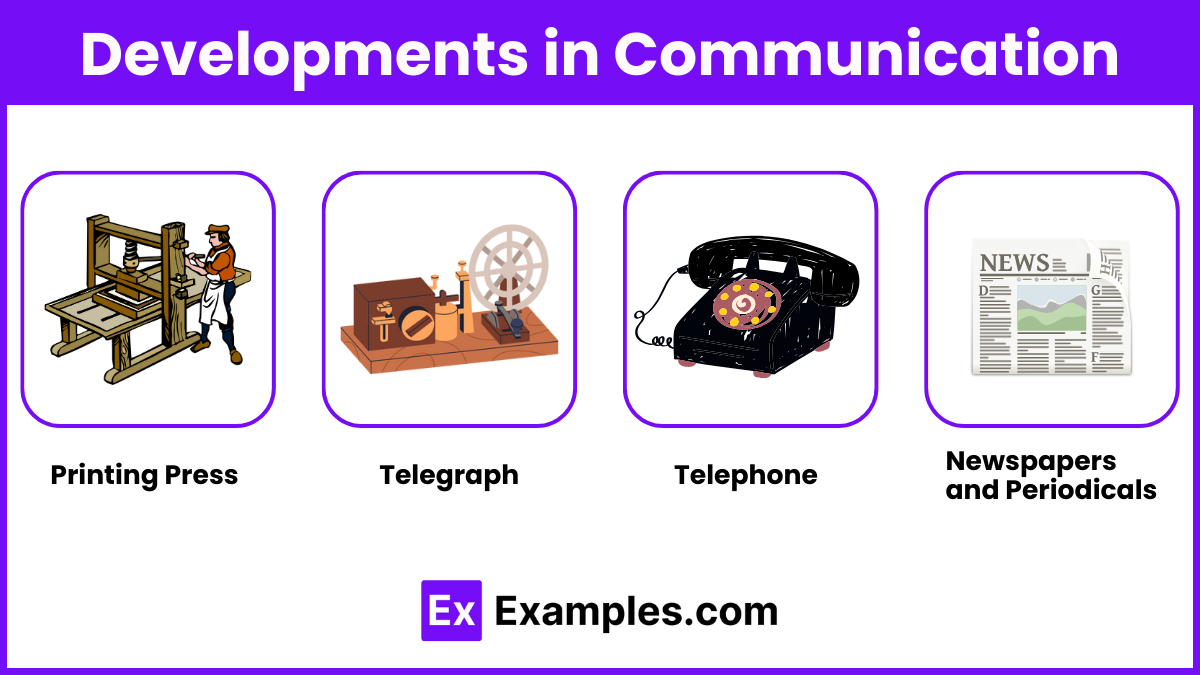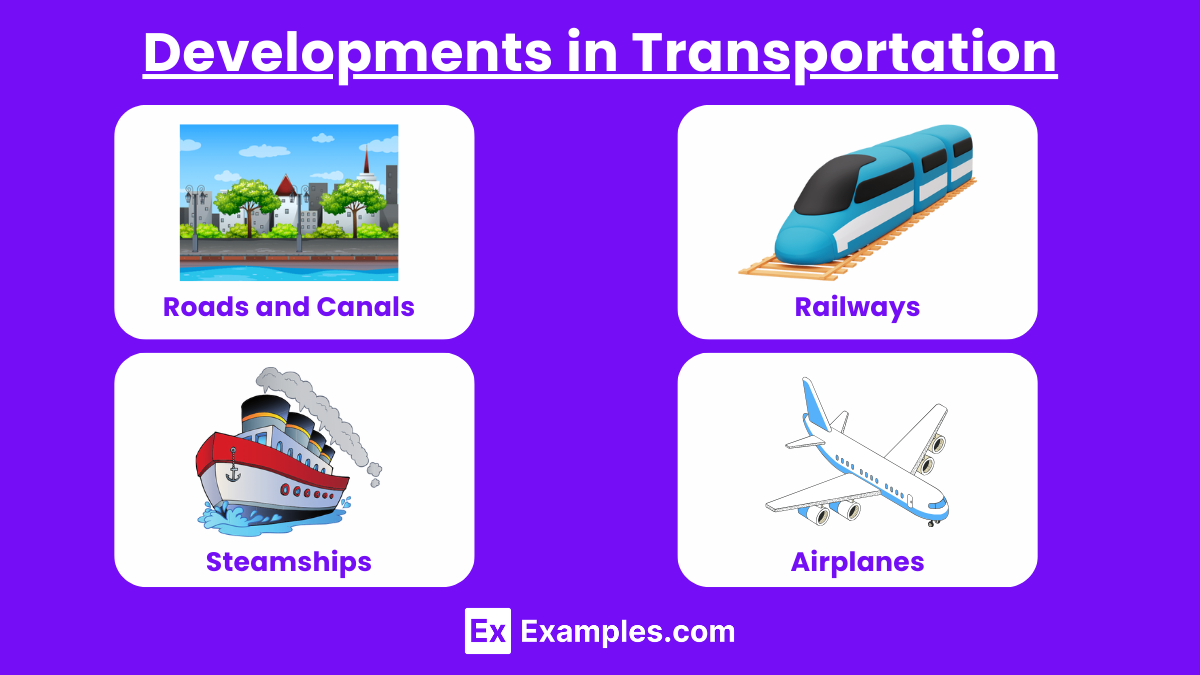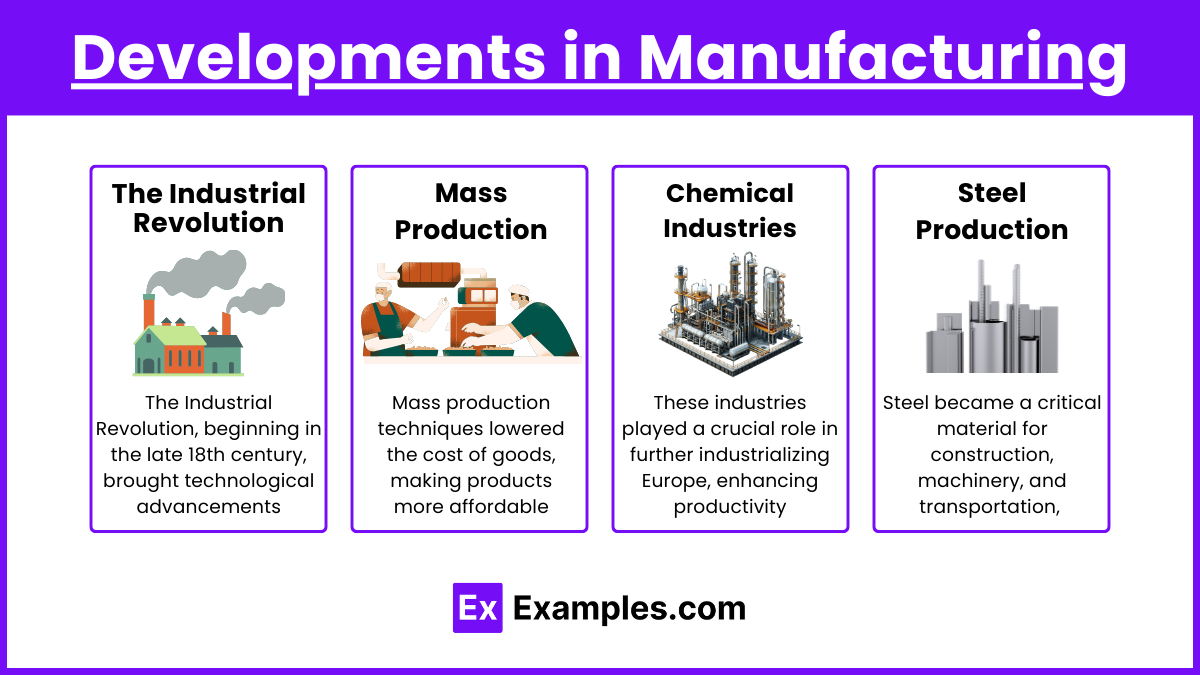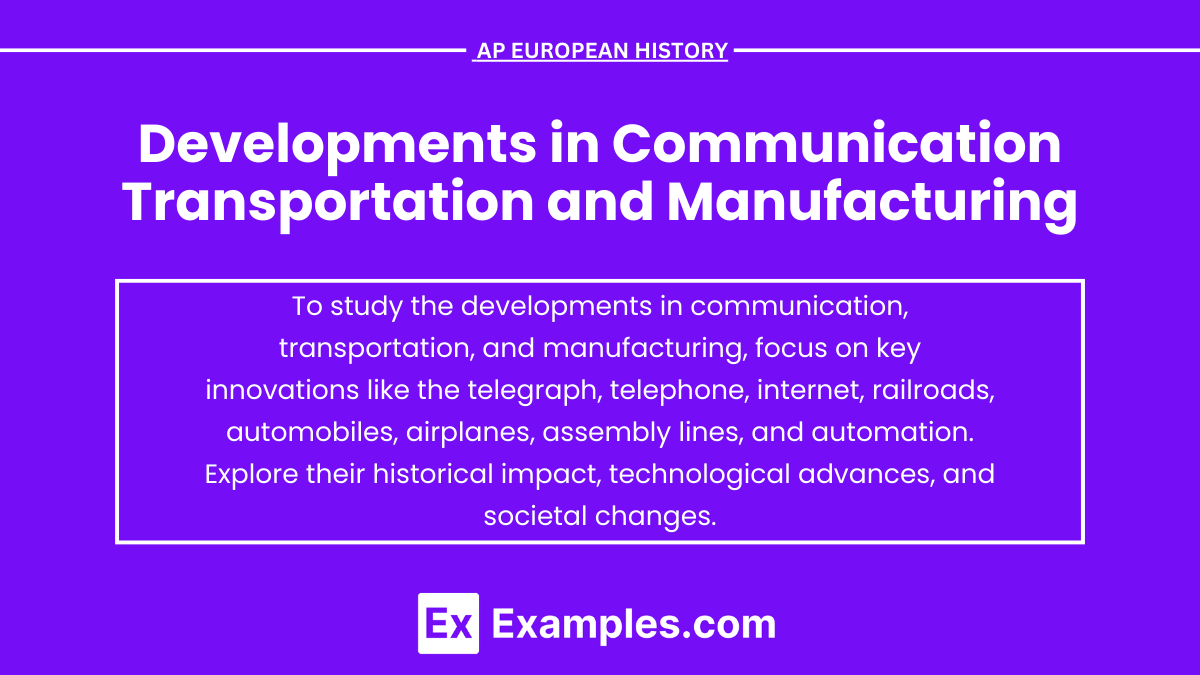The period from the 18th to the early 20th centuries marked a transformative era in Europe, characterized by significant advancements in communication, transportation, and manufacturing. These developments, including the invention of the printing press, telegraph, railways, and the Industrial Revolution, revolutionized the way people communicated, traveled, and produced goods. This era of innovation not only propelled economic growth but also reshaped societal structures and daily life, laying the foundation for the modern industrialized world.
Learning Objectives
In studying the “Developments in Communication, Transportation, and Manufacturing” for the AP European History exam, you should understand the key technological innovations and their origins, including the printing press, telegraph, railways, and the steam engine. Analyze the social, economic, and political impacts of these advancements on European society. Evaluate how these developments facilitated industrialization, urbanization, and globalization. Recognize the interconnectedness of these changes and their role in shaping modern Europe, influencing economic growth, social dynamics, and global interactions.
1. Developments in Communication

Printing Press
- Invention and Spread: The invention of the printing press by Johannes Gutenberg in the mid-15th century revolutionized communication. By the 18th century, it facilitated the widespread dissemination of ideas, including Enlightenment philosophies.
- Impact: It enabled the mass production of books and pamphlets, contributing to increased literacy rates and the spread of revolutionary ideas.
Telegraph
- Invention: The electric telegraph was developed in the early 19th century, with Samuel Morse’s Morse code system becoming widely used.
- Impact: The telegraph allowed for rapid communication across long distances, revolutionizing journalism, business, and government operations.
Telephone
- Invention: Invented by Alexander Graham Bell in 1876, the telephone further transformed communication by allowing voice transmission over long distances.
- Impact: It significantly enhanced personal and business communications, leading to the formation of the first global telecommunications networks.
Newspapers and Periodicals
- Expansion: The rise of newspapers and periodicals provided a platform for public discourse and the spread of information.
- Impact: They played a crucial role in informing the public, shaping public opinion, and promoting political and social movements.
2. Developments in Transportation

Roads and Canals
- Improvements: The 18th and early 19th centuries saw significant improvements in road networks and the construction of canals, such as the Bridgewater Canal in England.
- Impact: These developments facilitated the movement of goods and people, boosting trade and commerce.
Railways
- Invention: The development of the steam engine by James Watt and the subsequent invention of the locomotive by George Stephenson led to the first railways in the early 19th century.
- Impact: Railways revolutionized land transport, reducing travel time and cost. They enabled the mass movement of goods and people, fueling industrial growth and urbanization.
Steamships
- Invention: The introduction of steam-powered ships in the early 19th century, such as Robert Fulton’s Clermont, revolutionized maritime transport.
- Impact: Steamships greatly reduced travel time across oceans and rivers, facilitating international trade and the movement of people, including migration and colonization.
Automobiles and Airplanes
- Invention: The late 19th and early 20th centuries saw the advent of the automobile, with pioneers like Karl Benz and Henry Ford. The Wright brothers’ first successful flight in 1903 marked the beginning of aviation.
- Impact: These innovations further transformed transportation, making travel faster and more accessible, and leading to the development of global transportation networks.
3. Developments in Manufacturing

The Industrial Revolution
- Key Innovations: The Industrial Revolution, beginning in the late 18th century, brought significant technological advancements, including the mechanization of textile production, the use of steam power, and the development of machine tools.
- Impact: These innovations increased production efficiency and output, leading to the rise of factories and the growth of industrial cities.
Mass Production
- Henry Ford and Assembly Line: The introduction of assembly line production by Henry Ford in the early 20th century revolutionized manufacturing.
- Impact: Mass production techniques lowered the cost of goods, making products more affordable and accessible to a wider population.
Chemical and Electrical Industries
- Growth: The late 19th century saw the growth of the chemical industry, producing dyes, fertilizers, and explosives, and the electrical industry, with innovations like the light bulb and electrical power generation.
- Impact: These industries played a crucial role in further industrializing Europe, enhancing productivity and improving the quality of life.
Steel Production
- Bessemer Process: The invention of the Bessemer process in the mid-19th century made steel production more efficient and cost-effective.
- Impact: Steel became a critical material for construction, machinery, and transportation, supporting the expansion of infrastructure and industrial capacity.
The developments in communication, transportation, and manufacturing from the 18th to early 20th centuries were interconnected and collectively spurred the Industrial Revolution. These innovations not only transformed European economies but also had profound social and cultural impacts, shaping the modern world. Understanding these developments is crucial for comprehending the broader historical context of modern Europe and the forces that have shaped contemporary society.
Examples of Developments in Communication, Transportation, and Manufacturing
- Internet and Mobile Communication : The advent of the internet and mobile communication has revolutionized the way people connect, share information, and conduct business. Innovations like 5G technology enhance data transfer speeds, enabling more reliable and instantaneous communication globally.
- High-Speed Rail Networks : High-speed rail networks, such as Japan’s Shinkansen and the European TGV, have transformed transportation by reducing travel time between major cities. These trains travel at speeds exceeding 200 miles per hour, providing a fast, efficient, and environmentally friendly alternative to air travel.
- 3D Printing (Additive Manufacturing) : 3D printing, also known as additive manufacturing, has significantly impacted the manufacturing industry. This technology allows for the creation of complex and customized products with reduced material waste, revolutionizing prototyping, production, and logistics.
- Electric Vehicles (EVs) : The development of electric vehicles (EVs) marks a major shift in transportation. EVs offer a sustainable alternative to traditional gasoline-powered cars, reducing carbon emissions and dependence on fossil fuels. Companies like Tesla, Nissan, and General Motors have been at the forefront of this innovation.
- Smart Factories and Industry 4.0 : The concept of Smart Factories, driven by Industry 4.0, integrates advanced technologies like the Internet of Things (IoT), artificial intelligence (AI), and robotics into manufacturing processes. This development enhances production efficiency, reduces downtime, and allows for greater customization and flexibility in manufacturing.
Practice Test Questions on Developments in Communication Transportation and Manufacturing
Question 1: Which technological advancement significantly reduced the time taken to send messages across long distances during the 19th century?
A) Telephone
B) Telegraph
C) Radio
D) Television
Answer: B) Telegraph
Explanation: The telegraph revolutionized communication in the 19th century by allowing messages to be sent quickly over long distances via electrical signals. This innovation drastically reduced the time it took to communicate compared to traditional methods like letters. The invention of the telegraph, particularly by Samuel Morse, played a crucial role in linking different parts of the world and was a precursor to modern communication technologies.
Question 2: What was the major impact of the invention of the steam engine on transportation?
A) It increased the speed and efficiency of land travel.
B) It made air travel possible.
C) It improved the safety of maritime navigation.
D) It reduced the cost of building infrastructure.
Answer: A) It increased the speed and efficiency of land travel.
Explanation: The steam engine, developed during the Industrial Revolution, had a profound impact on transportation. It enabled the creation of steam-powered trains and ships, which drastically increased the speed and efficiency of land and water travel. This innovation not only reduced travel times but also facilitated the movement of goods and people, contributing to economic growth and the expansion of trade routes.
Question 3: How did the introduction of the assembly line impact manufacturing in the early 20th century?
A) It reduced the need for skilled labor.
B) It decreased production costs and increased efficiency.
C) It led to the development of more sophisticated products.
D) It slowed down the manufacturing process.
Answer: B) It decreased production costs and increased efficiency.
Explanation: The introduction of the assembly line, popularized by Henry Ford in the early 20th century, revolutionized manufacturing processes. By allowing each worker to perform a specific task repetitively, the assembly line greatly increased efficiency and production speed while significantly reducing costs. This method also enabled mass production, making goods more affordable and accessible to the general public. It was a key factor in the rise of consumerism and the modern industrial economy.


